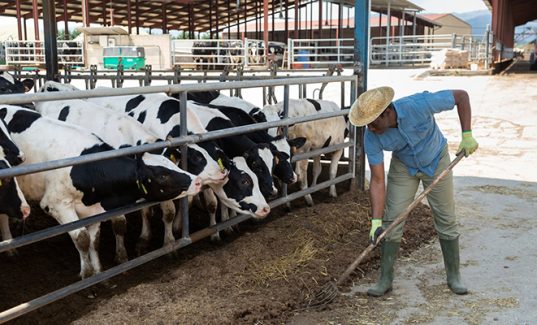Source: Associated Press
A costly divorce coupled with rock-bottom milk prices left dairy farmer Shane Giese deep in debt and uncertain about his future.
He had cut corners, buying cheaper feed for his cows and halting vaccinations. Those savings ended up costing him, however, as the animals began producing less milk. Behind on his bills and knowing change was needed, Giese turned things around with help from a state program intended to make Wisconsin’s dairy farms more profitable and sustainable.
The Dairy 30×20 Initiative aims to boost milk production in Wisconsin from about 27 billion pounds last year to 30 billion pounds per year by 2020 to meet growing demand from the state’s cheesemakers and milk processors. But Ben Brancel, secretary of the Department of Agriculture, Trade and Consumer Protection, said the program is often misunderstood because for years Wisconsin focused on making its farms bigger. That’s no longer the case. Now, Brancel said, the goal is to make farms more profitable so they survive.
“We wanted the farmers to decide what size they wanted to be, what type of farm they want to operate,” he said. “If they wanted to be big, so be it. If they wanted to be smaller and maybe a specialized farm, that was all well and good. If they were interested in grazing and weren’t sure how to get into it, if they were thinking they might like to incorporate a product like robotic milkers to create efficiencies on the farm . . . that was fine as well.”
The program provides about $200,000 per year in grants to help farmers with business planning, engineering, animal nutrition and other issues. Individual farms receive up to $5,000 and must put up $1,000 of their own money. Grants can’t be used to pay off debt or buy land or big equipment.
The dozens of farms that have received grants in the past two years ranged in size from 40 milking cows to 1,500, said Mike Bandli, who oversees the program for DATCP. Most sought help with business development, including expansion plans, or increasing profitability. But others needed help with such things as passing on farms between generations. The deadline for this year’s application is Dec. 2.
Giese, 39, put together a team of experts that included a veterinarian, extension agent and nutritionist. They sat down on his lawn in Pound, identified problems on the farm and came up with solutions. Giese bought better food for the cows, started a new vaccination program and took other steps to improve the animals’ health. Within months, he saw milk production increase from less than 60 pounds per cow per day to more than 70.
“I’m nowhere near out of the woods,” he said recently. “But it’s much better than it was two years ago. There is a light at the end of the tunnel there.”
Stacy Eberle, 49, of Monroe, applied for a grant after her husband died in a house fire in 2011. She had long wanted to expand from milking 50 to 100 cows, but his death forced her to take action. She couldn’t do all the work that it had taken both her and her husband to complete. And, she said, she still wanted to have time for their four daughters.
“In order to continue farming, I had the realization that I had to become more efficient, make things more modern,” Eberle said.
Her grant paid for engineering and design work on a new barn in which cows can roam freely instead of being tied in stalls. The open floor plan allows her to dispense feed with a tractor and mixer and to scrape manure with a skid loader. The machines reduce the time spent on such chores, allowing her to care for more cows in the same or less time than she needed before.
Her herd has grown to 125 milking cows, and she can foresee adding a robotic milking system in a couple of years, which would allow for greater expansion.




